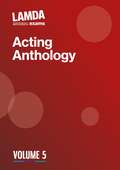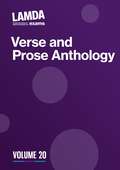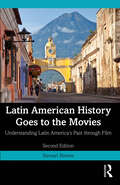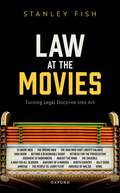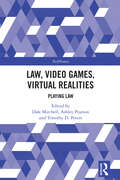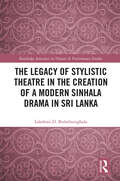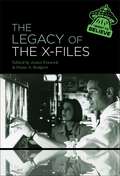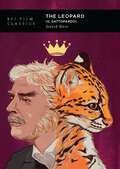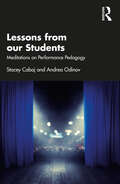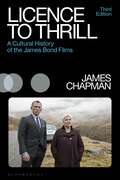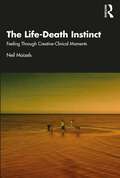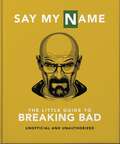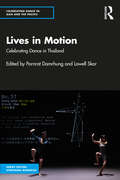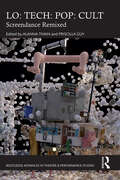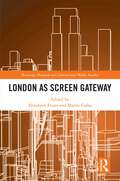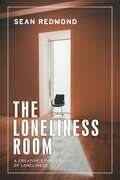- Table View
- List View
LAMDA Acting Anthology: Volume 5
by Lamda ExamsThis anthology presents the set selection of solo and duologue scenes for Learners entering LAMDA Graded Examinations in Performance: Acting from Grade 1 to Grade 5. The 100 speeches and scenes in this collection include excerpts from published plays and adapted novels, as well as new, original material written specifically for this anthology. There are monologues for solo performance and duologue scenes for two performers, all carefully curated to offer a broad range of material written by a variety of acclaimed playwrights, from Euripides, Shakespeare and Ibsen to Caryl Churchill, Chinonyerem Odimba and Jack Thorne. Also included is a foreword by actor and LAMDA graduate Ruth Wilson. For Learners taking LAMDA Examinations, this anthology offers a wide choice of characters and worlds to explore. There is material for younger candidates who are just entering the world of performance, as well as material for older, more experienced actors. For the general reader, this anthology is an ideal starting point for discovering the work of contemporary playwrights, as well as reconnecting with celebrated writers of the past.
LAMDA Verse and Prose Anthology: Volume 20
by Lamda ExamsThis anthology presents the set selection of verse and prose pieces for Learners entering LAMDA Graded Examinations in Communication: Speaking Verse and Prose from Entry Level to Grade 8, and LAMDA Introductory Graded Examinations from Stage 1 to Stage 3 (Solo and Group). The collection includes 155 pieces in total: a range of celebrated poems alongside prose extracts from bestselling classic and contemporary novels. It also features original material written specifically for this anthology, including the winner and runners-up of LAMDA Learners' Poetry Prize 2023. Also included is a foreword by Joseph Coelho, Waterstones Children's Laureate 2022–24. For Learners taking LAMDA Examinations, this anthology offers a wide choice of themes, topics and worlds to explore. With many performance possibilities, it is a perfect resource to help Learners practise and develop their communication skills. For the general reader, it is the ideal starting point for discovering contemporary poets and novelists, such as Maya Angelou, Malorie Blackman, Sally Rooney and Michael Rosen, as well as reconnecting with celebrated writers of the past, including Jane Austen, T. S. Eliot and William Wordsworth.
Latin American History Goes to the Movies: Understanding Latin America's Past through Film
by Stewart BrewerThis new edition of Latin American History Goes to the Movies uses a variety of feature films as a method of studying key historical themes in Latin America, from pre-Columbian cultures to contemporary debates. The book provides historical context as a way of interpreting Latin American filmography, offering multiple classroom viewing options per chapter theme. Each chapter is dedicated to a central concept or issue, such as stereotypes, conquest and colonialism, revolution, religion, gender, and politics. The second edition includes four additional chapters on dictatorships, LGBTQIA+ issues, the environment, and Indigenous peoples. Twenty new films, including La Fiesta del Chivo, Fresa y Chocolate, Embrace of the Serpent, and Roma appear throughout this edition, presenting additional perspectives and updates for today’s readers. The discussions of films and the history behind them offer a flexible and nuanced approach to understanding Latin American cultures, differentiating between stereotypical depictions and the realities of history. Concise and accessible, Latin American History Goes to the Movies is a unique resource for students and instructors in Latin American history and film studies to analyse developments in Latin America throughout previous centuries.
Latin American History Goes to the Movies: Understanding Latin America's Past through Film
by Stewart BrewerThis new edition of Latin American History Goes to the Movies uses a variety of feature films as a method of studying key historical themes in Latin America, from pre-Columbian cultures to contemporary debates. The book provides historical context as a way of interpreting Latin American filmography, offering multiple classroom viewing options per chapter theme. Each chapter is dedicated to a central concept or issue, such as stereotypes, conquest and colonialism, revolution, religion, gender, and politics. The second edition includes four additional chapters on dictatorships, LGBTQIA+ issues, the environment, and Indigenous peoples. Twenty new films, including La Fiesta del Chivo, Fresa y Chocolate, Embrace of the Serpent, and Roma appear throughout this edition, presenting additional perspectives and updates for today’s readers. The discussions of films and the history behind them offer a flexible and nuanced approach to understanding Latin American cultures, differentiating between stereotypical depictions and the realities of history. Concise and accessible, Latin American History Goes to the Movies is a unique resource for students and instructors in Latin American history and film studies to analyse developments in Latin America throughout previous centuries.
Law at the Movies: Turning Legal Doctrine into Art (Law and Literature)
by Prof Stanley FishThis book asks "How can legal doctrine be turned into filmic art?" By "legal doctrine" Stanley Fish does not mean the sonorous abstractions that usually accompany the self-presentation of law—Justice, Equity, Equality, Liberty, Autonomy, and the like. Rather he has in mind the specific rules and procedures invoked and analyzed by courts on the way to declaring a decision—lawyer/client confidentiality, the distinction between interdicted violence and the violence performed by the legal system, the interplay of positive law and laws rooted in morality, the difference between civilian law and military law, the death penalty, the admissibility of different forms of evidence. In the movies he discusses, these and other points of doctrine and procedure do not serve as a background, occasionally visited, to the substantive issues that drive the plot and provide the characters with choices; they declare the plot, and character is formed and tested in relationship to their demands. Apparently technical matters are pressed until they occupy both foreground and background and become the movie's true subject. If large, abstract concepts emerge, they emerge at the back end of doctrine and are, in effect, produced by doctrine. These are not law-themed movies; they are movies about the unfolding of legal process.
Law, Video Games, Virtual Realities: Playing Law (TechNomos)
by Dale Mitchell Ashley Pearson Timothy D. PetersThis edited volume explores the intersection between the coded realm of the video game and the equally codified space of law through an insightful collection of critical readings. Law is the ultimate multiplayer role-playing game. Involving a process of world-creation, law presents and codifies the parameters of licit and permitted behaviour, requiring individuals to engage their roles as a legal subject – the player-avatar of law – in order to be recognised, perform legal actions, activate rights or fulfil legal duties. Although traditional forms of law (copyright, property, privacy, freedom of expression) externally regulate the permissible content, form, dissemination, rights and behaviours of game designers, publishers, and players, this collection examines how players simulate, relate, and engage with environments and experiences shaped by legality in the realm of video game space. Featuring critical readings of video games as a means of understanding law and justice, this book contributes to the developing field of cultural legal studies, but will also be of interest to other legal theorists, socio-legal scholars, and games theorists.
Law, Video Games, Virtual Realities: Playing Law (TechNomos)
This edited volume explores the intersection between the coded realm of the video game and the equally codified space of law through an insightful collection of critical readings. Law is the ultimate multiplayer role-playing game. Involving a process of world-creation, law presents and codifies the parameters of licit and permitted behaviour, requiring individuals to engage their roles as a legal subject – the player-avatar of law – in order to be recognised, perform legal actions, activate rights or fulfil legal duties. Although traditional forms of law (copyright, property, privacy, freedom of expression) externally regulate the permissible content, form, dissemination, rights and behaviours of game designers, publishers, and players, this collection examines how players simulate, relate, and engage with environments and experiences shaped by legality in the realm of video game space. Featuring critical readings of video games as a means of understanding law and justice, this book contributes to the developing field of cultural legal studies, but will also be of interest to other legal theorists, socio-legal scholars, and games theorists.
The Legacy of Stylistic Theatre in the Creation of a Modern Sinhala Drama in Sri Lanka (ISSN)
by Lakshmi D. BulathsinghalaThis book explores the development of Sinhala stylistic drama from its earliest manifestations to the post-independence era.Bulathsinghala examines the impact of indigenous and imported folk theatrical forms on the work of the most significant postcolonial stylistic dramatists and on key plays that they produced. In the process, the book explores a number of myths and misunderstandings regarding Sri Lanka’s folk heritage and seeks to establish more reliable information on the principal indigenous Sri Lankan folk dramatic forms and their characteristics. At the same time, by drawing connections between folk drama and the post-independence stylistic theatrical movement, the author demonstrates the essential role of the former in Sinhala culture prior to the advent of Western and other influences and shows how both continue to inflect Sri Lankan drama today.This book will help to open the field of South Asian drama studies to an audience consisting not only of scholars and students but also of general readers who are interested in the fields of drama and theatre and Asian studies.
The Legacy of Stylistic Theatre in the Creation of a Modern Sinhala Drama in Sri Lanka (ISSN)
by Lakshmi D. BulathsinghalaThis book explores the development of Sinhala stylistic drama from its earliest manifestations to the post-independence era.Bulathsinghala examines the impact of indigenous and imported folk theatrical forms on the work of the most significant postcolonial stylistic dramatists and on key plays that they produced. In the process, the book explores a number of myths and misunderstandings regarding Sri Lanka’s folk heritage and seeks to establish more reliable information on the principal indigenous Sri Lankan folk dramatic forms and their characteristics. At the same time, by drawing connections between folk drama and the post-independence stylistic theatrical movement, the author demonstrates the essential role of the former in Sinhala culture prior to the advent of Western and other influences and shows how both continue to inflect Sri Lankan drama today.This book will help to open the field of South Asian drama studies to an audience consisting not only of scholars and students but also of general readers who are interested in the fields of drama and theatre and Asian studies.
The Legacy of The X-Files
by James FenwickThe Legacy of The X-Files examines the content and production of the show, its reception, its use of legend and folklore, its contemporary resonance in politics and society of the 21st century, and its impact and legacy on film, television, the Internet and beyond. Having converged with the early widespread use of the Internet, The X-Files became a cultural touchstone of the 1990s, transforming from a cult TV show into a pop cultural phenomenon by the end of the decade. To celebrate the 30th anniversary of The X-Files, this collection examines the content and production of the show, its reception, its use of legend and folklore, its contemporary resonance in politics and society of the 21st century, and its impact and legacy on film, television, the Internet and beyond. The series' themes of government mistrust, conspiracy, folklore, UFOlogy, and faith are dissected and applied to how the show spirituality resonated with post-Cold War Western society.Contributors to this collection discuss the wide-ranging impact of the television show in popular culture, from Mulder and Scully 'shippers' to the show's slogan entering the contemporary lexicon. The Legacy of The X-Files serves as an all-encompassing, multi-disciplinary, contemporary account of The X-Files, reflecting upon critical, historical, political, and social contexts, and featuring an in-depth and comprehensive introduction making it a vital work for researchers and students alike.
The Leopard (BFI Film Classics)
by David WeirLuchino Visconti's The Leopard (Il Gattopardo, 1963) tells the story of an aristocratic Sicilian family adjusting to the realities of political and commercial modernity after the unification Italy during the Risorgimento.The film, starring Claudia Cardinale, Burt Lancaster and Alain Delon, met with success upon its initial release, winning the Palme d'Or at Cannes and having a successful theatrical run in Europe. Despite this, however, it did not do well with English-speaking audiences, and eventually even fell out of favour with Italian audiences, who took issue with the way Risorgimento history was represented. David Weir's study of the film seeks to understand the film's paradoxical place in Italian film history. He argues that Visconti's use of artifice, narrative and history, all aspects that came to be criticised, were in fact, essential to his cinematic art, and can all be understood as strengths of the film. Providing a scene-by-scene analysis of the film, as well as illuminating its relationship to the Lampedusa novel from which it was adapted, Weir suggests that Visconti's film goes beyond mere adaptation, using the form of the novel for cinematic purposes and making The Leopard a cinematic novel in its own right. He goes on to situate the film within Visconti's career, questioning whether the uneven reception of the film reflects the paradox of Visconti's social status as a Marxist aristocrat and his position as an auteur director whose films borrowed heavily from the decadent tradition, while at the same time professing allegiance to the Italian Communist Party.
Lessons from our Students: Meditations on Performance Pedagogy
by Stacey Cabaj Andrea OdinovLessons from our Students: Meditations on Performance Pedagogy is a collection of thirty short personal case studies about pedagogical issues that arise in theater classrooms and rehearsals. Teaching in the acting and performance classroom is rapidly changing in the early 2020s. In the wake of the global pandemic, online education, massive trauma, and a social justice revolution, educators are seeking wisdom, clarity, and reassurance about their pedagogy. The authors speak to the current moment and the unique challenges of teaching theater by presenting a personal, practical, and authentic expression of vulnerability, humanity, and artistry as teachers. Through thirty personal meditations, the authors pose reflective questions and discussion prompts that evaluate the craft of teaching theater, issues that arise, and ideas about how to respond with vision and integrity. Accompanying exercises invite readers to reflect on their own teaching practices. This book serves as a text for theater teachers and teachers-in-training in search of inspiration, validation, and transformation in drama education and theater pedagogy classes.
Lessons from our Students: Meditations on Performance Pedagogy
by Stacey Cabaj Andrea OdinovLessons from our Students: Meditations on Performance Pedagogy is a collection of thirty short personal case studies about pedagogical issues that arise in theater classrooms and rehearsals. Teaching in the acting and performance classroom is rapidly changing in the early 2020s. In the wake of the global pandemic, online education, massive trauma, and a social justice revolution, educators are seeking wisdom, clarity, and reassurance about their pedagogy. The authors speak to the current moment and the unique challenges of teaching theater by presenting a personal, practical, and authentic expression of vulnerability, humanity, and artistry as teachers. Through thirty personal meditations, the authors pose reflective questions and discussion prompts that evaluate the craft of teaching theater, issues that arise, and ideas about how to respond with vision and integrity. Accompanying exercises invite readers to reflect on their own teaching practices. This book serves as a text for theater teachers and teachers-in-training in search of inspiration, validation, and transformation in drama education and theater pedagogy classes.
Licence to Thrill: A Cultural History of the James Bond Films (Cinema and Society)
by Prof James ChapmanIn this new edition of Licence To Thrill, James Chapman builds upon the success of his classic work, regarded as the definitive scholarly study of the history of the James Bond film series from the first picture, Dr No (1962), to the present. He considers the origins of the films in the spy thrillers of Ian Fleming and examines the production histories of the films in the contexts of the British and international film industries.This edition includes a new introduction and chapters on Quantum of Solace (2008), Skyfall (2012), Spectre (2015) and No Time to Die (2021). Chapman explores how the films have changed over time in response to developments in the wider film culture and society at large. He charts the ever-evolving Bond formula, analysing the films' representations of nationhood, class, and gender in a constantly shifting cinematic and ideological landscape.
The Life-Death Instinct: Feeling Through Creative-Clinical Moments
by Neil MaizelsThroughout this enlightening collection, Neil Maizels considers the helical tandem between the Life Instinct and the Death drive in the light of canonical literary figures like Thomas Hardy, Patricia Highsmith, Sylvia Plath and Shakespeare, classic filmmakers like Hitchcock and contemporary television shows such as Curb Your Enthusiasm, The West Wing and Succession. This light is filtered through intricate clinical work whereby Maizels seeks to illustrate and expound on the strength and indefatigability of the Life Instinct. He makes a case for it as the relentless driver of integration and “binding” in the ever-growing, expansive psyche. He considers both Freud’s original equation of the Life Instinct with Eros and a widening interconnecting love of mankind, and Melanie Klein’s with gratitude and creative reparation. This book is a multi-layered presentation of the clinical and theoretical work of Neil Maizels as it has evolved and convolved over several decades. It places the feeling through of one’s conflicts at the heart of the mind’s generation of a unique identity, equipped to evolve its own unique form of creative spirit in the face of life’s most pressing psychological challenges: the limitation of time, and reciprocated beauty. The Life-Death Instinct: Feeling Through Creative-Clinical Moments is important reading for anyone seeking to expand their knowledge in this fascinating intersection of psychoanalysis and the arts.
The Life-Death Instinct: Feeling Through Creative-Clinical Moments
by Neil MaizelsThroughout this enlightening collection, Neil Maizels considers the helical tandem between the Life Instinct and the Death drive in the light of canonical literary figures like Thomas Hardy, Patricia Highsmith, Sylvia Plath and Shakespeare, classic filmmakers like Hitchcock and contemporary television shows such as Curb Your Enthusiasm, The West Wing and Succession. This light is filtered through intricate clinical work whereby Maizels seeks to illustrate and expound on the strength and indefatigability of the Life Instinct. He makes a case for it as the relentless driver of integration and “binding” in the ever-growing, expansive psyche. He considers both Freud’s original equation of the Life Instinct with Eros and a widening interconnecting love of mankind, and Melanie Klein’s with gratitude and creative reparation. This book is a multi-layered presentation of the clinical and theoretical work of Neil Maizels as it has evolved and convolved over several decades. It places the feeling through of one’s conflicts at the heart of the mind’s generation of a unique identity, equipped to evolve its own unique form of creative spirit in the face of life’s most pressing psychological challenges: the limitation of time, and reciprocated beauty. The Life-Death Instinct: Feeling Through Creative-Clinical Moments is important reading for anyone seeking to expand their knowledge in this fascinating intersection of psychoanalysis and the arts.
The Little Guide to Breaking Bad: The Most Addictive TV Show Ever Made (The\little Book Of... Ser.)
by Orange Hippo!"I am not in danger, Skyler. I am the danger!"When a mild-mannered chemistry teacher teamed up with a small-time meth dealer - and, over five chaotic and addictive seasons, transforms into a ruthless kingpin - nobody expected the show to become a global sensation. But the gripping tale of Walt's descent into the criminal underworld has smashed records, making Breaking Bad the most critically acclaimed show of all time.Now the legacy of this trailblazing series has been refined into the gift that keeps on giving. Say My Name: The Little Guide to Breaking Bad is contaminated with the loco misadventures of Walt, Jesse, Skyler, Saul, Gus, Mike and Hank through a wealth of wicked wit and wisdom, and classic, killer catchphrases. Just remember, tread lightly - we wouldn't want you to get hooked on the show all over again. Or would we?
Lives in Motion: Celebrating Dance in Thailand (Celebrating Dance in Asia and the Pacific)
by Pornrat Damrhung Lowell SkarLives in Motion celebrates dance in Thailand, focusing on the diversity of Thailand’s dance cultures and their place in today’s world. Giving voice to eminent artists and scholars on the complex roles that Thailand is pursuing for artful movement at home and abroad, the book provides key perspectives on Thai dance traditions and practitioners. It explores the many forms and meanings in contemporary dance, changing local traditions in the country, the evolution of Thai dance on the global stage, and hybrid features of the Thai dance world. The book examines how hybridity has been integral to dance cultures in Thailand and discusses how they have actively adapted and negotiated their knowledge in relation to modernity and globalization. Developing new models, standards and sites for dance, movement and theater, dance in Thai has been advancing in innovative ways, whether it is to include fresh forms of skilled bodily movement or to expand in new arenas like tourism and online platforms. Similarly, old systems of training, which included artists’ homes, palaces, and temples, have been adapted into the new world of modern education, media, home schooling, and new community rituals. A pioneering contribution on Thai performing arts, this volume examines contemporary Thai dance cultures in the local, national, regional, and global contexts. It will be of great interest to scholars and researchers of dance and performance studies, cultural studies, Southeast Asia studies, and art.
Lives in Motion: Celebrating Dance in Thailand (Celebrating Dance in Asia and the Pacific)
Lives in Motion celebrates dance in Thailand, focusing on the diversity of Thailand’s dance cultures and their place in today’s world. Giving voice to eminent artists and scholars on the complex roles that Thailand is pursuing for artful movement at home and abroad, the book provides key perspectives on Thai dance traditions and practitioners. It explores the many forms and meanings in contemporary dance, changing local traditions in the country, the evolution of Thai dance on the global stage, and hybrid features of the Thai dance world. The book examines how hybridity has been integral to dance cultures in Thailand and discusses how they have actively adapted and negotiated their knowledge in relation to modernity and globalization. Developing new models, standards and sites for dance, movement and theater, dance in Thai has been advancing in innovative ways, whether it is to include fresh forms of skilled bodily movement or to expand in new arenas like tourism and online platforms. Similarly, old systems of training, which included artists’ homes, palaces, and temples, have been adapted into the new world of modern education, media, home schooling, and new community rituals. A pioneering contribution on Thai performing arts, this volume examines contemporary Thai dance cultures in the local, national, regional, and global contexts. It will be of great interest to scholars and researchers of dance and performance studies, cultural studies, Southeast Asia studies, and art.
LO: Screendance Remixed (ISSN)
This edited collection assembles international perspectives from artists, academics, and curators in the field to bring the insights of screendance theory and practice back into conversations with critical methods, at the intersections of popular culture, low-tech media practices, dance, and movement studies, and the minoritarian perspectives of feminism, queer theory, critical race studies and more.This book represents new vectors in screendance studies, featuring contributions by both artists and theoreticians, some of the most established voices in the field as well as the next generation of emerging scholars, artists, and curators. It builds on the foundational cartographies of screendance studies that attempted to sketch out what was particular to this practice. Sampling and reworking established forms of inquiry, artistic practice and spectatorial habits, and suspending and reorienting gestures into minoritarian forms, these conversations consider the affordances of screendance for reimaging the relations of bodies, technologies, and media today.This collection will be of great interest to students and scholars in dance studies, performance studies, cinema and media studies, feminist studies, and cultural studies.
LO: Screendance Remixed (ISSN)
by Alanna Thain Priscilla GuyThis edited collection assembles international perspectives from artists, academics, and curators in the field to bring the insights of screendance theory and practice back into conversations with critical methods, at the intersections of popular culture, low-tech media practices, dance, and movement studies, and the minoritarian perspectives of feminism, queer theory, critical race studies and more.This book represents new vectors in screendance studies, featuring contributions by both artists and theoreticians, some of the most established voices in the field as well as the next generation of emerging scholars, artists, and curators. It builds on the foundational cartographies of screendance studies that attempted to sketch out what was particular to this practice. Sampling and reworking established forms of inquiry, artistic practice and spectatorial habits, and suspending and reorienting gestures into minoritarian forms, these conversations consider the affordances of screendance for reimaging the relations of bodies, technologies, and media today.This collection will be of great interest to students and scholars in dance studies, performance studies, cinema and media studies, feminist studies, and cultural studies.
London as Screen Gateway (Routledge Research in Cultural and Media Studies)
by Elizabeth Evans Malini GuhaLondon as Screen Gateway explores how London features within screen narratives and as a location of screen industry activity. Reflecting the diversity of roles the city plays both on screen and within the screen industries, the volume explores the intersection between London as a material place and its position within a cultural imaginary. Conceptualising London as an archival city, as a collection of specific places and spaces, and as a part of national and international cultural and economic flows, contributors from film studies, television studies and media studies approach London through the lenses of textual analysis, historical work, industry studies and user experience. Chapters explore how London has appeared on screen across film and television, how screen content frames notions of place and belonging within the diasporic communities across the city, how the city has become a hub for the UK and global screen industries and how it intersects with national and local media policy. This interdisciplinary volume will be of interest to scholars and students of film studies, television studies, media industry studies, games studies, cultural and media studies.
London as Screen Gateway (Routledge Research in Cultural and Media Studies)
London as Screen Gateway explores how London features within screen narratives and as a location of screen industry activity. Reflecting the diversity of roles the city plays both on screen and within the screen industries, the volume explores the intersection between London as a material place and its position within a cultural imaginary. Conceptualising London as an archival city, as a collection of specific places and spaces, and as a part of national and international cultural and economic flows, contributors from film studies, television studies and media studies approach London through the lenses of textual analysis, historical work, industry studies and user experience. Chapters explore how London has appeared on screen across film and television, how screen content frames notions of place and belonging within the diasporic communities across the city, how the city has become a hub for the UK and global screen industries and how it intersects with national and local media policy. This interdisciplinary volume will be of interest to scholars and students of film studies, television studies, media industry studies, games studies, cultural and media studies.
The loneliness room: A creative ethnography of loneliness (Anthropology, Creative Practice and Ethnography)
by Sean RedmondThis remarkably unique book takes the conceit of the loneliness room to show how everyday artistic practice opens up loneliness to new definitions and new understandings. Refusing to pathologise loneliness, the book draws on the creative submissions supplied by its participants to demonstrate that being lonely can mean different things to different people in differing contexts. Filled with the photographs, paintings, videos, songs, and writings of its participants, The loneliness room is a deeply moving account of loneliness today.https://sredmond4.wixsite.com/lonelyroom
The loneliness room: A creative ethnography of loneliness (Anthropology, Creative Practice and Ethnography)
by Sean RedmondThis remarkably unique book takes the conceit of the loneliness room to show how everyday artistic practice opens up loneliness to new definitions and new understandings. Refusing to pathologise loneliness, the book draws on the creative submissions supplied by its participants to demonstrate that being lonely can mean different things to different people in differing contexts. Filled with the photographs, paintings, videos, songs, and writings of its participants, The loneliness room is a deeply moving account of loneliness today.https://sredmond4.wixsite.com/lonelyroom
